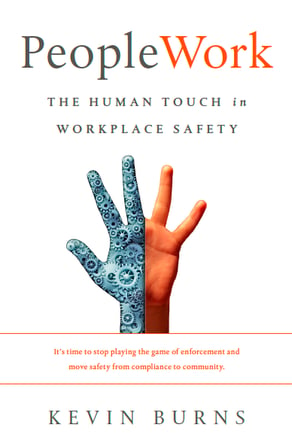The Battle For Better Safety
The battle for safety is not about safety at all.
 Engagement, or a lack of it, is the biggest problem in the workplace today. The Gallup surveys tell us that 71% of employees are NOT fully engaged. Safety suffers when engagement is missing. How could it not be? If people aren’t engaged in their work, then they aren’t going to be engaged in safely doing their work.
Engagement, or a lack of it, is the biggest problem in the workplace today. The Gallup surveys tell us that 71% of employees are NOT fully engaged. Safety suffers when engagement is missing. How could it not be? If people aren’t engaged in their work, then they aren’t going to be engaged in safely doing their work.
Why has this not become a massive battle by companies to re-connect their people with their work? Because the command-and-control model of management pushes rules-enforcement instead of relationship-building. In my new book, PeopleWork: The Human Touch in Workplace Safety, I write that more rules, more procedures and more processes heaped on to people who aren't engaged, aren’t connected and aren’t paying attention just isn’t going to work. If you want people to pay attention to safety, you first have to get them to pay attention. That means engage first.
A 71% level of disengagement is a serious drop in focused-attention productivity. This should be the battle you’re fighting in your efforts to improve safety performance. Lost productivity and disengaged safety performance creates a huge financial mess forcing companies to continue to pay more and get less. You'd think that there would be a hue-and-cry from the corporate executives to find solutions intended to curb this very real problem that is plaguing our workplaces and costing us money. But there isn't.
Engagement isn’t being talked about in safety circles. They’re still talking about more processes and procedures to fix an obvious engagement problem. But because it’s called an "employee" engagement problem, safety doesn’t know how to fix that.
Here are three ways you can begin to improve engagement levels with employees:
1It’s not just employees. The Gallup engagement findings are not reflective of only employees. It includes supervisors and managers too. Although the higher up you go in the organization, the lower the disengagement numbers. Disengaged supervisors don’t engage teams. Unmotivated supervisors don’t motivate their crews. Poorly trained supervisors feel over their heads and out of their element. When one lacks confidence with the job, engagement lacks too. It’s commendable that organizations want their front-line supervisors to know the safety rules and procedures. But without the proper skill-set to connect with, engage and motivate personnel, the default position is rules enforcement. Preaching rules is tough to buy-in to. So get some proper management skills to the front-line supervisors. Give them the tools to be far more effective and … wait for it … engaging.
2People connect with people. Why are safety meetings mostly about text-laden PowerPoint slides, inspection reports and process reviews? People don’t connect with rules, or slides, or boring reviews of procedures. People connect with people. Supervisors with great people-skills can turn a collection of individuals into a cohesive, tight team. An ability to effectively connect with people starts with your view of people. If you view them as people who can’t be trusted to do the right thing when you’re not standing over them, you’ll never connect with them. But if you view them as good people who want to make good decisions and you care about them as people, you will find it easy to connect.
3Make them a part of something special. People who feel like their voice matters connect better. When they know their ideas help and that they feel valued, they will begin to improve their levels of engagement. If their voices don’t matter, if their ideas are shot down and if their jobs are hung over their heads as a threat, you will never get them to engage. They'll do just enough to not get fired.  And if this is your management style, seriously you need some help. How do you fix it immediately? Think about that one boss you had that made you feel special or valuable. Do what he or she did to increase your attention and effort. Ask yourself at every opportunity, “what would he/she do here?” And then do that.
And if this is your management style, seriously you need some help. How do you fix it immediately? Think about that one boss you had that made you feel special or valuable. Do what he or she did to increase your attention and effort. Ask yourself at every opportunity, “what would he/she do here?” And then do that.
The battle for better safety isn’t a battle about safety at all. It’s a battle for attention and engagement. Win that battle and you will increase your success and a team-effort safety culture.
Kevin Burns is a management consultant, safety leadership speaker and author of PeopleWork - The Human Touch in Workplace Safety. Kevin Burns helps organizations integrate caring for and valuing employees through their safety programs. In addition to consulting with and facilitating discussions between all levels of management and supervisory, Kevin can also give engaging, entertaining and inspiring presentations to front-line employees at safety meetings. He is based in Calgary, Canada.
©2016 ZeroSpeak Corporation and Kevin Burns.
No part of this post may be reproduced without the expressed consent of the author.


